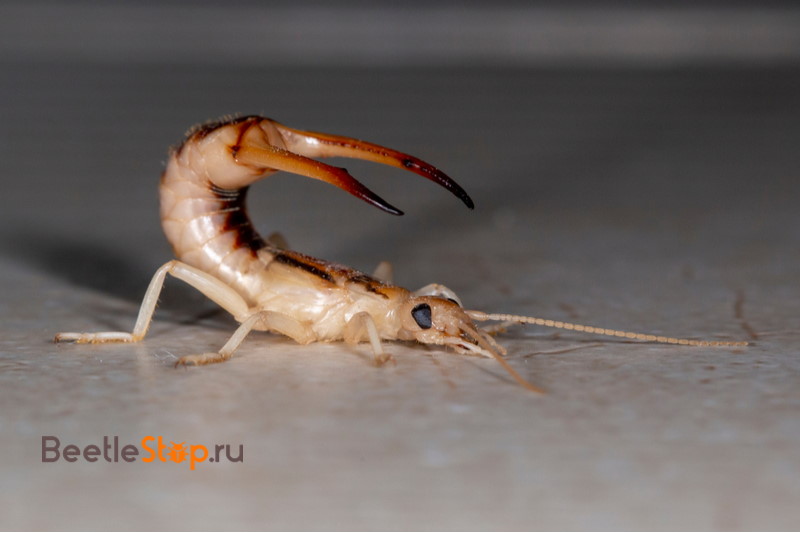Coastal earwig - a caring mother in the sand dunes
About 2 thousand species of insects with incomplete transformation are included in the detachment of skin-winged or earwigs. Omnivorous earwigs are active at night, from the sunlight they hide the floor with stones, bark, plants. The front wings of insects are short and dense, the posterior membranes. Because of the bifurcated appendages in the form of ticks, they are called double-tailed. The coastal earwig is distinguished by its love of moist places and sandy soil. She rarely uses wings, but during the breeding season there are flights in search of partners.
Morphological description of the species
The coastal earwig (Labidura riparia) belongs to the earwig family. The color of the insect varies from sand to red-brown. Antennae and limbs are bright. The body is oblong, flat, the length of an adult is 20-27 mm. The head is heart-shaped, eyes are small, facet type. The filiform tendrils consist of 11-14 cylindrical segments. Pronot square with transverse indentation in the middle. The color is sand, at the base a reddish spot with a dark border.

Elytra shortened, leathery, orange and wide brown stripes along the edge. Wings are membranous, transparent, well developed. Legs are running, they consist of three segments. The abdomen is wide and flat, the main color is light, with a longitudinal brown stripe on top.
Interesting fact. When folding, the coastal ear folds its wings twice when folded, using tick-borne appendages.
Tick-like appendages on the top of the abdomen give a peculiar appearance to the earwig of the coastal. They are called tserki. The inside is jagged, and the outside is smooth, curved. Forceps are light with darkened peaks. Ticks are designed to protect against enemies. In case of danger, insects bend the abdomen, exposing the weapon in front of the attacker. They can pinch a person painfully by the finger.
Sexual dimorphism
Forceps or ticks are developed in both sexes. In males, ticks are long and curved, sometimes they come against each other with their tips. Females are short and straight.
Habitat
The species Labidura riparia is a cosmopolitan. Insects can be found anywhere in the world, except Antarctica. They appear where there are sandy and sandy loamy soils located on the banks of water bodies. Many earwigs live in the tropical and subtropical zones. In Russia, the zone of their distribution reaches Kirov. In Japan, the subspecies Labidura riparia japonica, which is distinguished by a dark color, lives.
Lifestyle & Reproduction
A coastal earwig selects places near water. It settles down on sandy coasts and beaches near lakes, estuaries, rivers and seas. Spends daytime in a shelter (under stones, sand deposits, logs). With the onset of twilight creeps out to hunt. Earwigs feed on small insects and their eggs, plant debris, and fallen fruits. There are no nutritional features, but preference is given to live prey - larvae, eggs. The caught victim is held by ticks. Insects easily adapt to various conditions. In the absence of food, they engage in cannibalism, eating nymphs and eggs of their kind.
Information. Earwigs do not like to dig holes themselves, therefore they often occupy abandoned dwellings.Insects prefer to eat bursting fruits or those that have holes left by birds or caterpillars.
During the breeding season (late summer) you can find flying earwigs. Many males fly to the light. After mating, the female searches for a place to build a nest with several tunnels and exits. In it, she remains to winter and raise offspring. Having laid a bunch of 60-100 white cylindrical eggs, she stays with them. The earwig becomes aggressive, does not admit the male. This is justified, knowing the possibility of cannibalism.
The female licks the clutch, preventing infection by fungi and protects the offspring from destruction by predators. It moves masonry to places with high humidity. When soft white larvae appear, the mother does not abandon them, brings food and protects from dangers. Insects have well-developed offspring care. Cases were noted when the female confused the nests and began to care for other people's larvae. In the process of development, the little earwigs molt several times until they become an adult.
Myths and Facts About Earwigs
Insects cause panic in some people. This is due to the common myth that they can get into the ear, gnaw a hole in it, lay eggs. In fact, the probability of earwigs getting into the hearing organs is not higher than other insects. The name of the family is not due to bloodthirsty habits, but to the shape of folded wings resembling ears. Despite the wide distribution in some places, the number of coastal earwigs is declining. The species is listed in the Red Book of the Kaliningrad Region.

